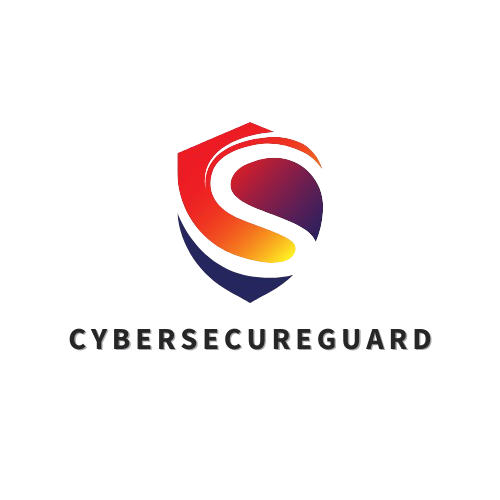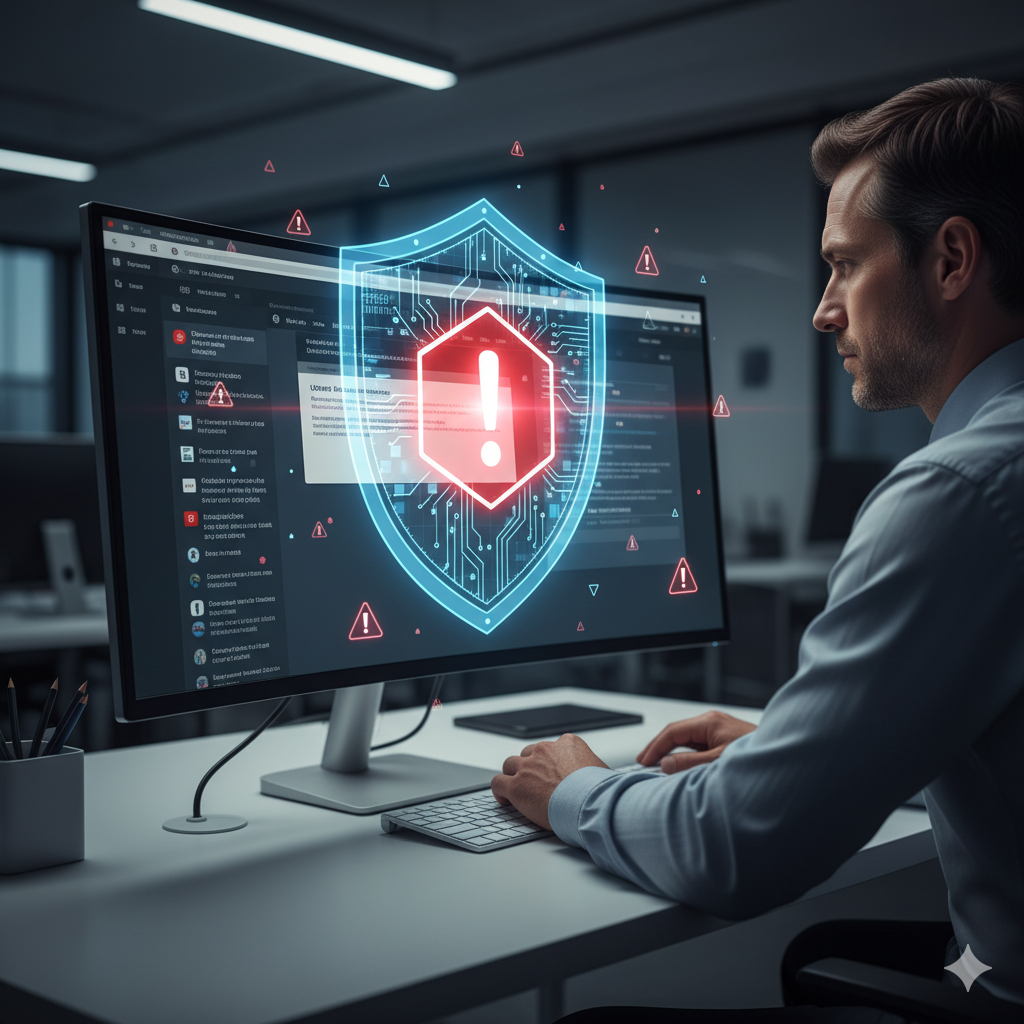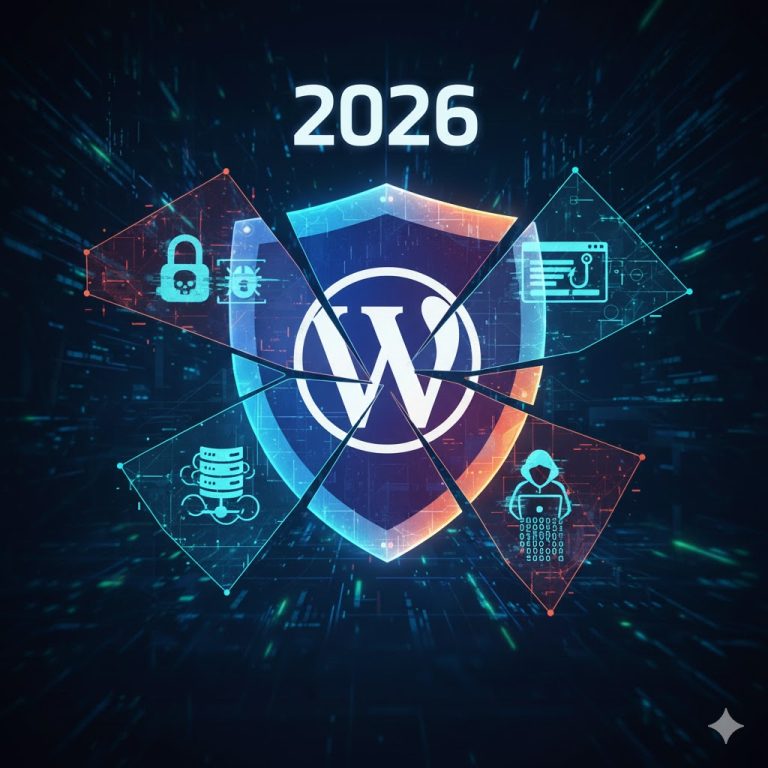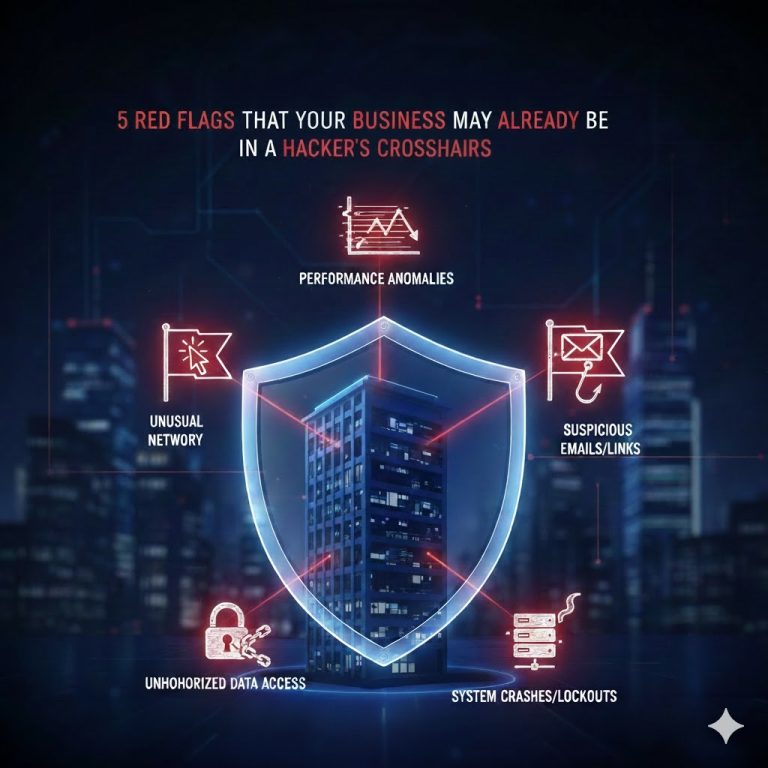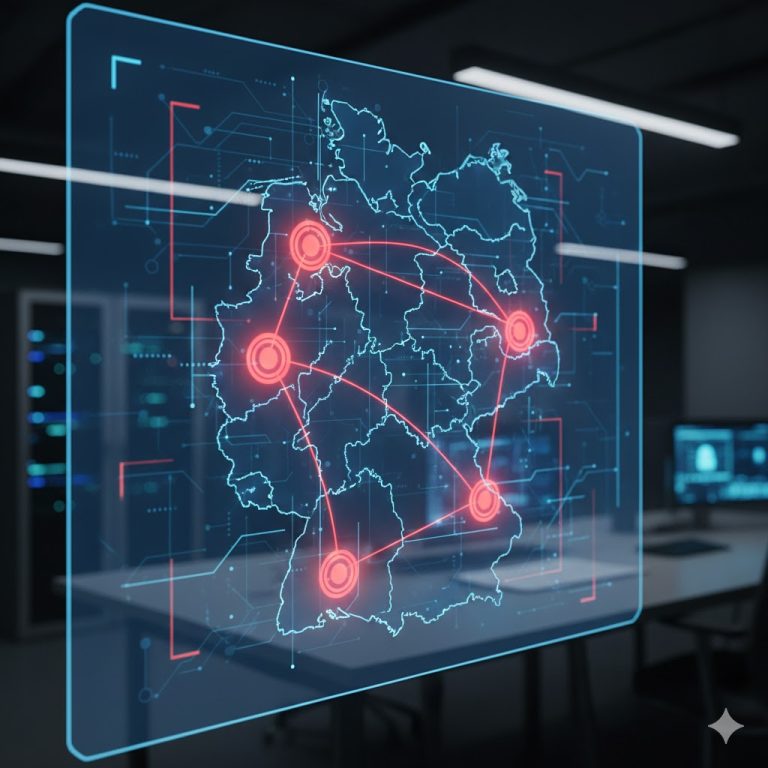Find out in this guide How to Identify Phishing Emails in the Workplace. Phishing remains one of the most common — and most effective — forms of cyberattack worldwide. Despite advanced spam filters and AI-powered email protection, attackers are constantly evolving. What used to be crude, obvious scams have transformed into highly sophisticated social engineering campaigns that exploit the one vulnerability no software can patch: human trust.
In 2025, phishing attacks have reached a new level of realism. They are no longer just about fake bank messages or “Nigerian prince” stories.
Today’s attackers combine artificial intelligence, cloned corporate websites, deepfake voice messages, and precise psychological profiling to impersonate legitimate partners, executives, or even automated system notifications. Their goal is simple but devastating — to trick employees into giving away login credentials, confidential data, or access to internal networks.
The financial and reputational impact can be severe.
A single successful phishing email can lead to data breaches, ransomware infections, or full-scale business compromise. For small and mid-sized companies, such incidents often result in weeks of downtime, regulatory fines, and loss of client confidence.
But here’s the truth many organizations overlook:
The biggest cybersecurity risk isn’t the technology itself — it’s how people interact with it.
Phishing preys on human instincts: curiosity, fear, urgency, and trust.
That’s why early recognition and awareness training are not optional — they’re your first and most effective line of defense against modern cyber threats.
In this guide, you’ll learn how to recognize dangerous phishing emails, what warning signs to look for, and how to build a company-wide reporting culture that turns your employees into your strongest security asset.
1. Understand What Phishing Looks Like Today
Phishing has evolved far beyond the era of poorly written spam and generic “update your account” messages. Modern campaigns are data-driven, automated, and highly personalized, making them nearly indistinguishable from real business correspondence. The reason they work so well is simple: today’s attackers study how organizations communicate, then mimic that style flawlessly.
Attackers no longer send millions of random emails hoping someone clicks. Instead, they use AI algorithms to analyze company websites, LinkedIn profiles, and public data leaks. Within minutes, they can craft tailored messages that reference actual projects, colleagues, or departments. Some even use deepfake voice notes or AI-generated signatures to reinforce credibility.
In modern business environments, you’re likely to encounter several sophisticated attack methods. Credential harvesting campaigns redirect employees to realistic login pages for Microsoft 365, Google Workspace, or internal portals. The design looks genuine, but the domain might differ by just one letter. Once credentials are entered, attackers gain full access to the mailbox and often use it to phish others inside the company. Invoice and payment fraud has become increasingly sophisticated, with fake billing emails from supposed vendors or partners asking for urgent transfers. These scams often follow real invoicing cycles or reference previous legitimate transactions, making them a classic sign of business email compromise.
Spear-phishing and CEO fraud involve targeted messages that impersonate senior management, typically asking employees to handle something discreetly, such as purchasing gift cards or approving a sensitive wire transfer. The key danger here is psychological pressure, as attackers exploit respect for authority. Malware-infected attachments remain a persistent threat, often disguised as PDFs, resumes, or Excel reports. Once opened, these attachments deploy malware that can log keystrokes, encrypt data, or create backdoors for later attacks. Meanwhile, cloud-based and collaboration attacks exploit tools like SharePoint, OneDrive, or Google Drive. Victims receive legitimate-looking file sharing invitations containing malicious links or scripts. Because the sender domain looks official, traditional spam filters often allow them through.
Modern phishing attacks look professional, use real branding, and adapt dynamically. AI systems can rewrite an email instantly if filters block it. Some campaigns even adjust wording based on the recipient’s language or role. That’s why every company, regardless of size, must treat phishing as a behavioral and cultural challenge, not just a technical one. When employees understand how phishing really works, they stop reacting emotionally and start thinking critically, turning every inbox into a controlled security checkpoint.
Why it’s so dangerous now
Modern phishing attacks look professional, use real branding, and adapt dynamically.
AI systems can rewrite an email instantly if filters block it. Some campaigns even adjust wording based on the recipient’s language or role.
That’s why every company — regardless of size — must treat phishing as a behavioral and cultural challenge, not just a technical one.
When employees understand how phishing really works, they stop reacting emotionally and start thinking critically — turning every inbox into a controlled security checkpoint.
2. Red Flags Every Employee Should Know
Even the most advanced phishing campaigns leave subtle traces of manipulation, digital fingerprints that reveal something isn’t right. Training employees to recognize these signs is one of the most powerful, low-cost defenses any organization can implement. The goal isn’t to turn everyone into a cybersecurity expert but to teach them to pause, verify, and think before they click.
Always look beyond the display name when examining sender information. Attackers often spoof trusted identities like suppliers, clients, or managers. Check the real sender address carefully, as support@microsoft-security.com is not the same as support@microsoft.com. Watch for minor typos or extra characters that are intentionally subtle, such as paypa1.com, micr0soft.net, or secure-update.io. On mobile devices, expand the “From” field, as fake senders rely on the fact that phones hide full addresses by default.
Phishing often disguises itself as routine business with messages like “Please confirm this invoice” or “Update your password,” but legitimate companies don’t ask for credentials or payment information over email. Ask yourself whether this person would normally contact you for this task. If the answer is no, or the request feels out of character, it’s time to verify through another channel such as phone, chat, or meeting.
Attackers know that pressure overrides logic. Messages that demand immediate action, threaten account suspension, or claim limited-time access are designed to make you click before you think. Phrases like “within 24 hours,” “final notice,” or “immediate verification required” are major red flags. Senior-impersonation scams that say “Please handle this confidentially” exploit respect for hierarchy and fear of delay. Remember that legitimate organizations give you time, while attackers don’t.
Many phishing emails now use AI, so grammar errors are rarer, but tone still reveals inconsistency. If a normally friendly colleague suddenly writes very formally, or a vendor’s style seems robotic, something’s off. For example, “Dear Sir, kindly process attached payment” should make you wonder whether your actual supplier would write like that. Even small deviations from established communication patterns should raise suspicion.
Before clicking any link, hover over it or long-press on mobile to preview the real destination. If it doesn’t clearly match the sender’s domain, do not click. Hidden redirects using services like bit.ly, tinyurl, or long tracking URLs are common concealment tactics. Legitimate services use HTTPS with a clear domain name, such as https://portal.company.com, not https://secure-login-verify123.biz. Bookmark official login pages for critical services and always access them directly instead of through links in emails.
If you weren’t expecting an attachment, treat it as hostile until proven safe. Never open .exe, .scr, .zip, or .js files from unknown senders. Even documents like .docx or .xlsm can contain malicious macros. Verify with the sender before opening anything that claims to be urgent. Modern attacks often use subjects like “fake invoice,” “resume,” or “contract update” that are realistic enough to trigger curiosity.
Generic greetings like “Dear Customer” or “Dear User” are rarely how your actual partners address you. Similarly, emails that don’t reference specific projects, account numbers, or details you recognize are probably automated scams. Legitimate communication almost always includes context such as invoice numbers, dates, or personal greetings.
Sophisticated phishing messages may show a legitimate link in the text but hide a malicious one behind it. For example, the text might display www.microsoft.com while the actual link points elsewhere. Always verify the real URL preview before you click, and if your email client warns you about mismatched addresses, heed the warning.
If an email promises rewards, discounts, or free tools that seem unusually generous, assume it’s bait. Cybercriminals exploit curiosity and greed as effectively as fear and urgency.
Create a simple mantra your employees can memorize: “Stop – Check – Verify.” Stop before you click, check sender, link, and language, and verify through a second channel if unsure. Building this pause into your company culture turns every employee from a potential victim into an active participant in your cybersecurity strategy.
3. Use Technical Protection – But Don’t Rely on It Alone
Technology is your first filter, not your final defense. Even the most advanced security solutions can’t fully prevent human mistakes — and attackers count on that. In fact, phishing remains the entry point for more than 80 percent of all successful cyberattacks worldwide.
A strong cybersecurity posture combines smart technology with alert people. Think of your technical controls as the locks on a door — solid and necessary — but in the end, your employees decide whether to open it.
Before exploring AI-based firewalls or behavioral filters, every organization should start with the fundamentals: email authentication. Three DNS-based mechanisms form the foundation of a secure mail environment.
SPF (Sender Policy Framework) specifies which servers may send emails on behalf of your domain.
DKIM (DomainKeys Identified Mail) adds a cryptographic signature that confirms each message’s authenticity.
And DMARC (Domain-based Message Authentication, Reporting & Conformance) ties both together, enforcing policies and generating reports on spoofing attempts.
Without these records in place, attackers can easily impersonate your company domain and deliver convincing fake messages to partners or staff. Configuring SPF, DKIM, and DMARC properly stops most spoofed emails before they ever reach an inbox.
Beyond authentication, a Secure Email Gateway (SEG) acts as your digital gatekeeper. It inspects every incoming message, analyzing links, attachments, and sender reputation in real time. Enterprise solutions like Proofpoint, Mimecast, Cisco Secure Email, and Barracuda offer advanced features such as attachment sandboxing and heuristic content analysis. Smaller companies can rely on integrated tools like Microsoft Defender for Office 365 or Google Workspace Security, which provide similar protection on a smaller scale.
Another essential layer is Multi-Factor Authentication (MFA). Even if a password is stolen through phishing, MFA can block unauthorized access. Requiring verification via an authenticator app — rather than a simple SMS code — prevents most credential-harvesting attacks. Employees should also learn to recognize so-called “MFA fatigue” attempts, where attackers bombard them with repeated login prompts to trick them into pressing Approve.
Regular maintenance is just as critical. Phishing often serves as a delivery mechanism for malware that exploits outdated software. Every unpatched browser, mail client, or plugin is an open door waiting to be used. Establish a strict patching policy: apply updates weekly, automate antivirus and EDR signature refreshes, and reboot systems so that fixes actually take effect. Even the best security suite is useless if it’s months out of date.
Proactive monitoring then ties everything together. By tracking unusual behavior — such as failed logins from unknown locations, sudden spikes in outbound messages, or odd network activity — you can detect compromised accounts before they escalate. For larger environments, integrating logs into a SIEM system like Splunk, Sentinel, or Elastic provides deep visibility. Smaller teams can use the built-in dashboards in Microsoft 365 or Google Admin Console to achieve similar oversight.
Finally, balance automation with human judgment. AI-driven protection can process millions of messages per day, but it still lacks context. Only a human can notice when “John from Finance” suddenly writes like a chatbot. Combine automated scanning with manual reviews for high-risk departments such as finance, HR, and executive accounts. Automation strengthens your perimeter — awareness strengthens your culture.
Technology builds walls. People build awareness. You need both.
When your systems are well-configured and your employees are well-trained, phishing emails stop being a threat. They become a daily test your team passes confidently — not by luck, but by design.
4. Establish a Reporting Culture
Technology may block millions of phishing attempts every day — but your employees face the most sophisticated ones directly in their inbox. Training them to recognize manipulation is not just another compliance exercise; it’s the foundation of long-term cybersecurity resilience.
In 2025, the most effective awareness programs go far beyond simple PowerPoint sessions. They teach people to think like attackers — to understand motives, patterns, and psychology. When employees grasp how phishing works from the adversary’s perspective, they begin to anticipate rather than merely react.
The key to this mindset shift is simulation and repetition. Real-world phishing simulations — tailored to your industry and communication style — give staff a safe way to experience deceptive emails firsthand. These exercises shouldn’t be designed to embarrass but to educate: they help employees feel the emotional pull of urgency, curiosity, or authority that real attackers exploit. After each campaign, short feedback sessions or micro-trainings reinforce lessons learned while the experience is still fresh.
However, effective awareness isn’t a one-time event; it’s an ongoing learning culture. Replace annual “click-through courses” with continuous micro-content — two-minute videos, quick quizzes, or short newsletters highlighting recent scams. People retain knowledge through exposure and repetition, not through single workshops. Make cybersecurity an everyday topic, not a yearly reminder.
Encourage open communication as well. When employees feel safe reporting suspicious emails — without fear of blame or ridicule — your detection capabilities multiply instantly. A supportive reporting culture turns mistakes into learning opportunities. Praise those who report potential phishing attempts; public recognition reinforces the behavior you want to spread.
Leadership plays a crucial role too. Executives who complete the same training as their teams send a powerful signal that security awareness is everyone’s responsibility. Senior managers are frequent phishing targets themselves, and when they model cautious behavior, it sets the tone for the entire company.
Finally, connect awareness to purpose. Employees are more likely to care about security when they understand the impact of a breach — not only financial loss but also the trust and reputation at stake. Relate phishing defense to protecting clients, safeguarding colleagues, and maintaining the company’s credibility. When cybersecurity feels personal, vigilance becomes habit.
Training employees to think like attackers transforms your team from passive users into active defenders. Over time, this mindset builds a human firewall — one that grows stronger with every reported email and every moment of awareness. Technology may detect threats, but it’s your people who decide whether they succeed.
5. Simulate Attacks to Build Real Awareness
Even with the best filters and awareness training, a phishing email will eventually slip through. What happens next determines whether your company stays safe — or suffers a full-scale breach.
The difference is not luck; it’s preparation.
A clear and well-rehearsed reporting and response plan ensures that suspicious messages are handled quickly, efficiently, and without panic. When employees know exactly what to do, they respond confidently instead of hesitating or guessing.
The first step is to make reporting simple and visible. Every email client used in your organization — Outlook, Gmail, or others — should include a one-click “Report Phishing” button or shortcut. The goal is to eliminate friction; no one should have to wonder whom to contact or how to escalate a threat. For smaller teams, a dedicated mailbox such as security@yourdomain.com or a secure chat channel in Teams or Slack works just as well.
Once an alert is received, a defined triage process begins. The IT or security team examines the reported email, reviewing headers, URLs, attachments, and sender domains. Using analysis tools such as VirusTotal, Any.Run, or built-in security dashboards, they quickly determine whether the email is a false alarm or an active threat. If confirmed malicious, the incident is logged, blocked, and removed from other inboxes using administrative tools.
For more serious cases — especially those involving credential compromise or malware execution — escalation must follow a predefined chain of command. The plan should identify who makes decisions about containment, communication, and external reporting. Larger organizations often include PR or legal teams at this stage to manage potential reputational and compliance risks.
An effective response plan also defines communication clarity. Employees should receive transparent updates about the incident: what happened, what was done, and what precautions to take. The goal is not to spread fear but to build trust. When staff see that reports lead to real action, they’re more likely to remain engaged and proactive.
After each incident, conduct a post-incident review. Ask key questions:
-
How quickly was the threat reported?
-
Were there any delays or confusion in the escalation process?
-
Did the filters or technical tools miss something that can now be improved?
Use these insights to refine both your awareness campaigns and your detection systems. Phishing defense is iterative — each experience makes the next response stronger.
Finally, make sure your response plan is documented, accessible, and regularly tested. A plan that sits unused on a shared drive won’t help in an emergency. Schedule short tabletop exercises or simulated phishing incidents every quarter to ensure everyone knows their role. These dry runs build the muscle memory needed to act calmly and efficiently under pressure.
A well-prepared reporting and response plan doesn’t just limit damage — it builds confidence. It shows employees that their vigilance matters and that every report contributes to a larger defense strategy.
When awareness and process come together, even the most convincing phishing attempt becomes just another test — one your company is ready to pass.
6. The Phishing Awareness Formula – How to Build Long-Term Resilience
Phishing awareness isn’t a one-time campaign or an annual training video.
It’s an ongoing process — a balance of education, empowerment, and evolution.
Technology changes, threats adapt, and so must your people.
The most secure companies in 2025 don’t rely on expensive firewalls alone.
They invest in something far more valuable: a culture where every employee becomes part of the defense.
The Four Pillars of Sustainable Awareness
To build lasting resilience, integrate these four principles into your cybersecurity strategy:
1️⃣ Educate Continuously
Security training should evolve as fast as the threats.
Move away from once-a-year presentations — they’re forgotten by next week.
Instead, provide bite-sized learning every month: short articles, micro-videos, or real phishing examples from your inbox.
Tip: Use internal newsletters or quick Slack reminders. Repetition builds intuition.
2️⃣ Empower Employees, Don’t Intimidate Them
Fear-based security messaging backfires.
When people feel judged or embarrassed, they hide mistakes instead of reporting them.
Empower them with simple rules, positive reinforcement, and leadership support.
“If you’re unsure — report it. There’s no penalty for being careful.”
That one sentence can save an entire company.
3️⃣ Evaluate and Adapt
Track how your team’s awareness improves over time.
Monitor metrics like click rate, report rate, and response time.
When data shows improvement, share it — celebrate it.
When weaknesses appear, adjust the training approach.
Cybersecurity isn’t static; it’s an ecosystem that grows with you.
4️⃣ Encourage Vigilance at Every Level
Executives are just as vulnerable as interns.
In fact, leadership impersonation (“CEO fraud”) remains one of the most lucrative attack types.
Make sure awareness training applies to everyone — from front desk to C-suite.
A culture of vigilance is built when leadership models caution, not just delegates it.
Build Awareness Into Everyday Workflow
Awareness only sticks when it’s part of the routine.
Integrate security checkpoints into normal operations:
-
Encourage double verification for payment requests.
-
Add a “Report Suspicious” shortcut to internal tools.
-
Include phishing scenarios in onboarding sessions.
-
Review recent phishing attempts during monthly meetings.
Small, consistent actions form habits — and habits form resilience.
The Mindset Shift: From Defense to Preparedness
True cybersecurity isn’t about avoiding every threat. It’s about responding faster and smarter when threats appear.
Phishing awareness creates that mental readiness — a shared alertness that protects not just data, but your company’s reputation.
Every cautious click, every reported email, every quick double-check contributes to that collective shield.
Over time, those moments of awareness compound — turning your organization from an easy target into a trusted, cyber-resilient brand.
Educate. Empower. Evaluate. Encourage.
These four steps form the foundation of lasting phishing resilience.
Technology may evolve — but awareness remains your most reliable defense.
By turning awareness into daily behavior, your team doesn’t just avoid threats —
they anticipate them.
And that is the difference between being protected and being prepared.
Conclusion – How to Identify Phishing Emails in the Workplace
Phishing isn’t just a technical problem — it’s a test of awareness, culture, and communication.
Attackers rely on speed, confusion, and trust, while true cybersecurity relies on clarity and discipline.
When employees know how to spot unusual requests, verify senders, and report suspicious messages, they become more than just users — they become your first line of defense.
Every reported email, every moment of hesitation before clicking, strengthens your organization’s digital immune system.
The more people understand the psychology behind phishing, the less power these attacks hold.
In 2025, technology alone isn’t enough.
Firewalls can filter messages — but only trained, alert minds can filter intent.
That’s why awareness isn’t a cost — it’s an investment in your company’s long-term security and reputation.
Stay alert, stay informed, and make awareness your competitive advantage.
Please also read:
AI-Phishing Emails: Why They’re Harder to Detect Than Ever
Exposing phishing emails: How to recognize fraud attempts – safely and systematically
Follow me on Facebook or Tumblr to stay up to date
Connect with me on LinkedIn
Take a look at my services
And for even more valuable tips, sign up for my newsletter
